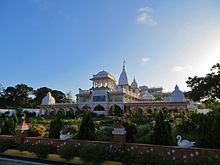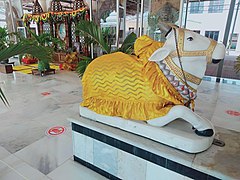The following outline is provided as an overview of and topical guide to Hinduism:

Hinduism is the third largest religion in Australia consisting of more than 684,002 followers, making up 2.7% of the population as of the 2021 census. Hinduism is the fastest growing religion in Australia mostly through immigration. Hinduism is also one of the most youthful religions in Australia, with 34% and 66% of Hindus being under the age of 14 and 34 respectively.

Hinduism is the Fourth-largest religion in Myanmar, being practised by 1.7% of the population of Myanmar. Hinduism is practised by about 890,000 people in Myanmar, and has been influenced by elements of Buddhism, with many Hindu temples in Myanmar housing statues of the Buddha. There are also a large population of Hindus in which the Myanmar Tamils and minority Bengali Hindus having the biggest population share.

Hinduism is a minority religion constituting about 0.15% of the population of Austria. Hinduism is not one of the 16 recognised religions in Austria. The Austrian law allows religious groups not recognized as societies to seek official status as confessional communities with the Office for Religious Affairs. Hinduism is one of the eight confessional communities in Austria. However, the Sahaja Yoga and the International Society for Krishna Consciousness are categorised as associations, not as confessional communities.

Hindu Swayamsevak Sangh is a non-profit, social, educational, and cultural organization of the Hindus living outside India. It was founded in 1940s in Kenya, it is currently active in 156 countries and estimates 3289 branches.

Hinduism is a minority religion in Korea. There are 24,414 Indians in South Korea, most of whom are Hindus. Through Buddhism, it has also had an indirect impact on certain aspects of traditional Korean thought. The Four Heavenly Kings that can be seen in Korean Buddhist temples originated from the Lokapālas. Also Skanda,Daeyejeok Geumgang, Sakra,Yama and Brahma were worshipped.

Radha-Krishna is the combined form of the Hindu god Krishna with his chief consort and shakti Radha. They are regarded as the feminine as well as the masculine realities of God, in several Krishnaite traditions of Vaishnavism.

Hinduism is the second largest religion in New Zealand. It is also one of the fastest-growing religions in New Zealand. According to the 2018 census, Hindus form 2.65% of the population of New Zealand. There are about 123,534 Hindus in New Zealand.

The BAPS Shri Swaminarayan Mandir of Houston, Texas is a traditional Hindu temple built by the BAPS Swaminarayan Sanstha. It is in unincorporated Fort Bend County, Texas, within the extraterritorial jurisdiction (ETJ) of Stafford and with a Stafford mailing address.

BAPS Shri Swaminarayan Mandir, Nairobi is a Hindu temple in Nairobi, Kenya. Although there were temples in Africa before this, it is the first traditional stone and marble Hindu temple to be constructed on the African continent and was built by BAPS Swaminarayan Sanstha, a Hindu denomination within the Swaminarayan Sampradaya. It was opened on 29 August 1999 by Pramukh Swami Maharaj, the 5th spiritual leader of BAPS Swaminarayan Sanstha.

Hinduism is a minority religion in Belgium. According to the PEW 2014, Hinduism is also the fastest growing religion in Belgium. Attempts have been done by the Hindu Forum of Belgium (HFB) to make Hinduism an officially-recognized religion in Belgium.

The earliest evidence of Hinduism in Tanzania is from the 1st millennium AD when there was trade between East Africa and Indian subcontinent. Most of these traders came from Gujarat, Deccan and the Chola empire. Archaeological evidence of small Hindu settlements have been found in Zanzibar and parts of Swahili coast, Zimbabwe and Madagascar.

Hinduism is a minority religion in Scotland. A significant number of Hindus settled there in the second half of the 20th century. At the time of the 2001 UK Census, 5,600 people identified as Hindu, which equated to 0.1% of the Scottish population and was slightly above the number of Hindus in Wales. In the 2011 UK Census, the number of Hindus in Scotland almost tripled to over 16,000 adherents.

Hinduism in England is the third largest religion in the country, with over 1,020,533 followers as of the 2021 Census. This represents over 1.5% of the English population, up from 1.1% the previous decade. Hindus are predominantly in the cities of London and Leicester, where they make up greater proportions of the population. England has a number of Hindu temples, including the Hindu temple at Neasden which is a large Hindu temple in Europe. In 2007, the largest Hindu Mandir in the North of England, the Bradford Lakshmi Narayan Hindu Temple opened in Bradford, West Yorkshire.

Hinduism is a minority religion in Wales constituting 0.4% of its population. Under half of Welsh Hindus settled there in the second half of the 20th century.
The Shree Sanatan Hindu Mandir is the name of two Hindu temples in London, one situated off the Ealing Road in Wembley, in the Brent and the other in Whipps Cross in Waltham Forest near Leytonstone. They are run by charity Shri Vallabh Nidhi UK.




















